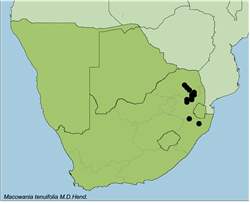Names and synonyms
Macowania tenuifolia M. D. Henderson
Type
Mogg 20116, Gauteng, Nigel, Vrisgewaag G 337, 8 miles SE of Nigel (PRE).
Derivation of names
Macowania = after Dr. Peter MacOwan (1830-1901), botanist, director of the Cape Town Botanic Gardens, and discoverer of new species at the Cape.
tenuifolia = with thin, slender leaves
Diagnostic characters
Erect shrub
Leaves gradually tapering to an acute tip
Leaves always white woolly on the lower surface between the midrib and the revolute margins
Midrib strongly raised below
Peduncles bracteate
Description
Erect shrub 0.6-1 m tall and slightly more in diameter. Stems densely leafy when young, bare with prominent leaf scars below, branching profusely terminally forming dense cushions. Leaves imbricated, up to 20 mm long, less than 1 mm broad, linear, tapering gradually to the acute tip, margins strongly revolute, upper surface glossy with sparse glands on surface and midrib below, glands short-stalked; lower surface white woolly between margins and midrib, midrib broad and strongly raised below. Capitula solitary at the branch tips, sessile or on short bracteate peduncles. Involucre funnel-shaped, 8-10 x 8-10 mm. Involucral bracts green and turning straw-coloured when old, often with traces of white wool particularly near the base, minutely glandular on the back. Ray florets yellow, female. Disc florets yellow, hermaphrodite, corolla of disc flowers narrowly cylindric below, widening gradually above, with a few hairs immediately below the expanded part. Pappus of about 15-17, barbed bristles. Cypsela 3-4.5 mm long, 10-ribbed, sparsely covered in silky-white hairs.
Flowering time
Mainly in September and October, but are also found flowering earlier and later.
Distribution
Ranges from northernmost KwaZulu-Natal (utrecht, Paulpietersburg, Vryheid districts) west to Nigel on the Gauteng (Suikerbosrand) and Mpumalanga (Lydenburg, Dullstroom, Belfast districts) highveld and north along the mountains to The Downs near Tzaneen.
Known from more than 30 specimens.
Habitat
Grows in grassland on rock outcrops and rocky ridges.
Notes
The leaves are always white woolly on the lower surface between the midrib and the revolute margins, although the margins may be inrolled to obscure this completely.
M. pulvinaris is very closely allied to M. tenuifolia from which it is distinguished by its dwarf habit, less attenuated leaf tips and ebracteate peduncles.
A very interesting observation was made in specimens of Macowania tenuifolia from Kemp's height near Lydenburg. Contrary to the other genera (Relhania, Leysera, Rosenia) in the group, the capitula of these Macowania specimens did not close at night or in cold conditions. The ray florets remain spreading at all times. I have not observed other Macowania species to establish if they show the same phenomenon.
References
ANDERBERG, A.A. 1991. Taxonomy and phylogeny of the tribe Gnaphalieae (Asteraceae). Opera Botanica 104: 50-53.
GLEN, H.F. 2004. SAPPI, What's in a Name? The Meanings of the Botanical Names of Trees. Jacana.
HENDERSON, M.D. 1961. Compositae in New and interesting taxa from southern Africa in Kirkia 1: 110-118.
HILLIARD, O.M. & BURTT, B.L. 1976. Notes on some plants of southern Africa chiefly from Natal: V. Notes from the Royal Botanic Garden Edinburgh 34,3: 260-276.
HILLIARD, O.M. 1977. Compositae in Natal. University of Natal Press.
KESTING, D. & CLARKE, H. 2008. Botanical names, what they mean. Wild Flowers of the Cape Peninsula, 3rd revised edition. Friends of Silvermine.
